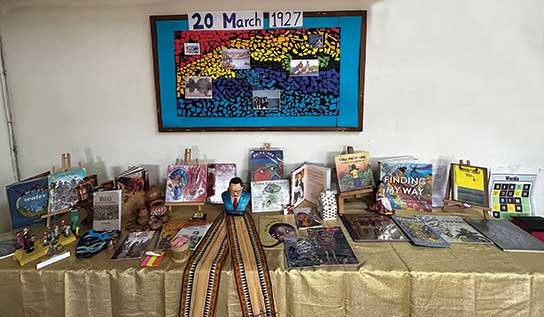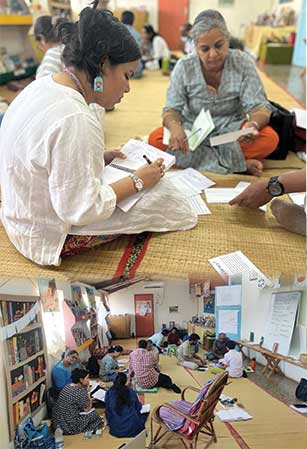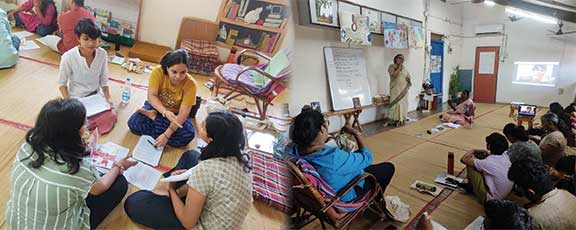Darpana Baria
Libraries are dynamic places for exploring and engaging. I see this clearly in my role as a Primary Years Programme (PYP) librarian working at Hill Spring International School, Mumbai. In an IB school, libraries play a pivotal role in supporting the curriculum and creating a lifelong love for reading. At our school, the library is the ‘Learning and Resource Centre (LRC)’, which holds a curated collection of more than 25,000 books. This collection becomes the core for communication, collaboration, and connection at the school.
As a PYP librarian, with a focus on thinking skills, encouraging students to become thinkers is an integral part of my role. I draw upon Margaret Mead’s words, “Children must be taught how to think, not what to think” to guide my work.

The term ‘critical literacy’ is not the same as ‘critical thinking’. While I was aware of this difference, I had not explored the former consciously in my practice as a librarian. When Bookworm, Goa offered a workshop on Critical Literacy in the Library, my interest was piqued. I viewed this opportunity as a new milestone in my learning journey. It was a window to view children and the library space in a new light. I was already familiar with Bookworm’s work and zest for children’s books and library practices through various online workshops and social media. The workshop’s concept note got me intrigued about critical pedagogy – a term entirely new to me. The three-day workshop aimed at exploring questions and not providing the participants with a ‘how-to’, which is more common in professional development workshops.
Some of the questions that stayed with me were –
• What is the group that constitutes children? When do we coin this category? What becomes essential for library work to keep in mind when working with children?
• What are some ways in which we can design the library experience to be democratic, collaborative, and transformative?
• How do we view our role as a library educator in the context of social justice?
This pilot workshop welcomed a group of diverse participants from different parts of India. Each one drew upon their exposure and experience in their library spaces, making it an authentic and meaningful exchange throughout the workshop.

While the Critical Literacy in the Library workshop examined the idea of caste and casteism through various texts, other resources, and engagements, it did sow a seed of looking at the world beyond the surface. It led to the idea of connecting with the world around us, as text. It was an invitation to put things into a larger perspective for me. The world around me has influenced my perception and the way I read text. This was a new way of approaching a piece of information.
During the workshop, we read an article – Telling different tales: possible childhoods in children’s literature by Deepa Sreenivas. This article dealt with a set of stories for older children. The three stories in the article were – Kali and the Rat Snake by Zai Whitaker, Trash: On Ragpicker Children and Recycling by Gita Wolf and Mumtaz Embroiders Her Dreams by Jolly Rohatgi. These stories, depending on who has written them, condition the norms through which we view childhood.
In the first story, Kali and the Rat Snake (Whitaker Z, 2000) – the story of Kali, a boy from the Irula community, a forest tribe of Tamil Nadu in India, Deepa Sreenivas points out that Kali, despite being a proud Irula member in school, is shown as having a low self-esteem. As a reader from the urban community, I never questioned this representation. But if we are to think ‘critically’ about the frame of the story – would Kali tell his story in the same way? Would it have been written differently and less from the point of view of someone looking in? This caused me as a reader to ponder over how we are reproducing ideas about communities.
The second story, Trash: On Ragpicker Children and Recycling (Wolf G, Ravishankar A and Sen O, 1999), is about Velu, a young boy who escapes an abusive father in the village to find himself lost and alone in the bustling city of Chennai, where he meets little Jaya, an experienced ragpicker. As highlighted by Deepa Sreenivas, the main narrative is glossed by a parallel narrative appearing in boxes. Little capsules of ‘Interesting facts’ are shared along with the narrative. The article locates a thread mediating the experiences of children through the eyes of an observer, distant and encyclopedic. The book restricts me, the reader, from seeing this story from Velu’s eyes. How many such books have I read and not questioned? If I want to have a 360° view of the world of children like Velu, then I also need to read more accounts written by communities and not just written to ‘teach’ some information.
The third story, Mumtaz Embroiders Her Dreams (Rahtogi J And Soni R, 2005), is woven around Mumtaz, a disabled girl from a Muslim artisan family in Hardoi in Uttar Pradesh. As pointed out by Deepa Sreenivas, the story does not ask us to question Mumtaz’s experiences as a poor-Muslim-girl in relation to the larger social world outside the magical, artisanal frame in which she is represented. Digging deeper into this untouched domain, I see the narrative of Mumtaz being narrowed to a marginal world that is familiar to her.
All the three stories led me towards one common understanding, which is also troubling. Children from various cultural, historical, and social contexts may have a voice in the story, but it remains unnoticed until there is a noise which certifies them as winners in times of adversity. We appear to think that it is unto the child/character who faces adversity to pull themselves out of the situation. These stories neither question the existence of adversities in the first place nor the role that we have as mainstream citizens in these social conditions.

As librarians and educators, we need to empower our children to recognize, question, and analyze the representation of information in facts as well as in fiction. As I make my way through these thoughts, the following questions trigger my thinking –
• Are children exposed to environments or engagements that spark their curiosity from a wide angle?
• Are childhood experiences universal? If yes, what is universal and what is particular?
• Do we allow children to question what is right or wrong? Are they aware of their rights? Do we have texts that exemplify this need?
• Are children driven towards an understanding of fairness, bias, authenticity, and perspectives shared through the nuances in a text? Or should we be putting text sets together to enable our children to get broader points of view?
The critical stance does not accept what is printed as truth, but questions who has the power in a text; whose viewpoint is being presented; and what the author appears to want the reader to think (McLaughlin and DeVoogd, 2004).
To me, critical literacy continues to be an area of exploration through various lenses moving towards the bigger picture of critical pedagogy, paving a path for new approaches to teaching and learning, leading to a constructive understanding.
Critical literacy must become a tool for making more informed choices. It gives us a sense of belonging and moulds us into conscious citizens. I feel proud as a librarian to bring this thinking into my library practices.
References
• Sreenivas D (2008) Different Tales. Hyderabad: Anveshi and Kottayam: DC Books.
• Manchester Metropolitan University. Renegotiating the Place of Fiction in Libraries through Critical Literacy. Accessed 7 July 2023.
• McLaughlin M. and DeVoogd, G. (2004) Critical Literacy: enhancing students’ comprehension of text. Scholastic.
The author is a school librarian who believes in fostering a love for books and reading within and beyond the school community. She can be reached at darpana.baria@hsieducation.org.
